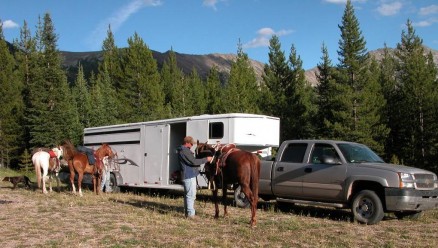 It shouldn’t be a surprise that horse trailering often comes with problems. After all, horses are prey animals. That means a horse is always on alert for the newest threat and they always want to have multiple escape routes open to them. That’s why horse prefers wide open spaces-they can scan the horizon for threats while plotting their escape should one really come along.
It shouldn’t be a surprise that horse trailering often comes with problems. After all, horses are prey animals. That means a horse is always on alert for the newest threat and they always want to have multiple escape routes open to them. That’s why horse prefers wide open spaces-they can scan the horizon for threats while plotting their escape should one really come along.
With that kind of outlook, imagine how getting in a horse trailer looks. You’re asking an animal that likes to have escape routes available to get into a small, confined space with only one way in or out. And you’re asking an animal that likes to scan wide open areas for threats to get in a confined space that could contain a threat of its own, or at the very least, block the view of what else might be going on.
So we can recognize that problems with horse trailering are actually completely natural, but how do we deal with them? The key is to approach this problem the same way you would with any other horse problem. First and foremost is leadership. You need to be a leader in the mind of your horse otherwise he’s not going to be willing to follow you into difficult or stressful situations.
It should already be part of your normal routine-but specifically when you’re planning on trying to get your horse in the trailer, take him nearby and run him through a groundwork routine before asking him to get in the trailer. Include some backing up, flexing, dropping the head, basic yields and above all some lunging. Gradually get the horse closer to the trailer.
When you’re near the trailer, it’s time to implement another strategy-getting the horse to see the trailer as a place of rest and comfort. Implement a new rule that’s going to be enforced during trailer training sessions. If the horse is right next to the trailer, he gets to rest. Away from the trailer, it’s time for some work (lunging will do). The first time you get near the trailer, let the horse walk up and smell it. It’s OK at that point if he doesn’t step in. Let him smell it and look it over, then walk him away for some more lunging for 2-3 minutes. Then approach again.
This time ask him to put a front foot in. Encourage this by putting some pressure, using a crop or carrot stick. Use a “driving game” approach and tap on his back to encourage him to go forward. When he does, take the pressure off. At first aim for small goals, asking the horse to put one foot at a time. When a goal is met, back the horse out of the trailer and start the process all over again. Go back to lunging for a couple of minutes, then walk him back up to the trailer, allow him to rest, and ask him to go in once again.
This is a process of approach and retreat. Right before the horse is going to come unglued, back him out of the trailer. This teaches the horse to stay calm. By building his confidence in small increments and avoiding the situation where he lets his fear the best of him, we slowly get him used to the idea that the trailer is safe and he will just walk right in.
Notice we haven’t talked about using any treats or placing grain the trailer to coax him in. This approach is based on being a leader for your horse, not trying to bribe him. Using this method will produce longer lasting results.
David McMahon is a freelance author and horse owner. He invites you to visit http://horse-training-tips.com where you can learn more about horse trailering.